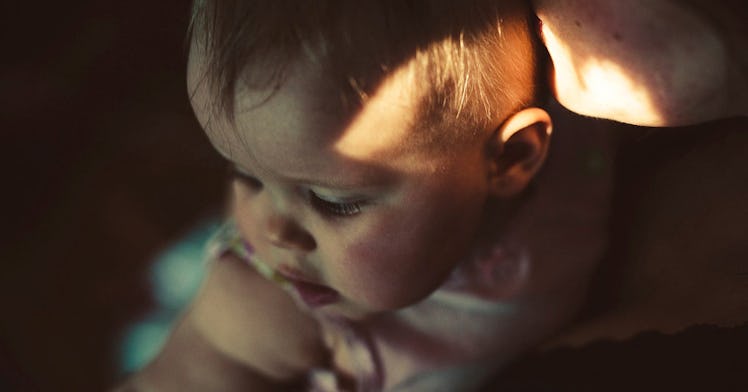The Only 3-Month Milestones That Matter
Stop stressing out and focus on the milestones that really matter.

Baby developmental milestones aren’t fixed or absolute — they’re more like waypoints, marking the course of typical infant development. Some 3-month-old babies may reach typical milestones early, while arriving at other milestones late. Some babies may skip certain milestones altogether. Instead of worrying about specifics regarding what to expect for 3-month milestones, parents should remember that milestones are generalized markers, not definite checkpoints. When parents look at their 3-month-old as a whole person instead of a set of skills that need to be measured, everyone benefits.
That being said, there is quality guidance available for understanding your baby’s growth and development. In February 2022, the Centers for Disease Control and Prevention and the American Academy of Pediatrics overhauled the pediatric milestone checklist. This process included adding developmental milestones for 15-month-olds and 30-month-olds, and revamping other milestone charts to reflect things most children (75% or more) can do by a certain age. To help parents track milestones on their own, the CDC has released a free Milestone Tracker mobile app, for iOS and Android devices, a Digital Online Checklist, and a PDF checklist that parents can download and print.
In the third month of your baby’s life, you should expect to see increased strength and social interaction. If you saw only glimmers of personality in month two, you should see them starting to display joy, boredom, and frustration in the coming weeks. With blossoming personality and strength comes the ability to indulge their curiosity. So month 3’s main infant milestones are about reaching out to touch you or grab things.
3-Month-Old Baby Milestone #1: Baby Should Be More Social
Your baby might have been slow to smile in the second month, but as the third month progresses, parents should see their baby flash a smile in response to play and activity. Along with that smile should come a change in facial expressions along with a bit of babble. They won’t be saying Mama or Dada yet, but you may hear some breathy gahs, ohs, guhs, and oos. The babble may be subtle or pronounced. It will definitely be slobbery.
If you’re lucky, you may be able to coax a belly laugh from your kid while you play. On the other hand, your 3-month-old baby may start crying when play is done. These are all great signs of on-point development, but they also require a little coaxing from parents. Playing with a baby (at this point, this means making different sounds and facial expressions) is essential for the kid. Without this interaction, babies can’t practice their mimicry and may be a bit slower to gain social skills.
Red Flags: Parents need to leave room for babies who are hesitant to offer social responses. But there is a difference between a baby who appears reluctant or slow to react to parents and a baby who appears incapable of a social response. The red flag here is more about the absence of a set of behaviors. A baby who doesn’t laugh or coo, but does smile, is likely just taking their time. The same goes for a baby who looks interested in their parent, coos and babbles, but doesn’t smile. You may simply want to take some time to see if anything changes in the coming weeks. But a baby who seems completely disinterested, does not babble, look at parents, or smile, may need to see their pediatrician sooner rather than later. This could be a sign of any number of neurological disorders that can be addressed with early intervention.
What You Shouldn’t Stress About: At this age, it’s normal for babies to fuss and cry, particularly when they’re bored, or something they enjoy has been taken away. They may also cry when they are put down. This is normal. If you suspect there is a deeper issue, there’s no harm in talking to your pediatrician.
3-Month-Old Baby Milestone #2: Baby Should Start Reaching for and Grabbing Things
At 3-months-old, the spark of play is lit. Babies should be able to reach and grasp for things they are curious about, and may start to explore cause-and-effect by bopping things that make noise when grasped or jostled. Granted, this play is primitive and might look more accidental than intentional. Still, embedded in the play is proof that on a physical level, things are clicking along. A newborn who can play in these very basic ways is showing that they can see and track objects and coordinate their limbs. A baby that repeatedly bops or kicks an object that makes sound shows that they’re developing muscle strength and that they can respond to auditory cues.
Red Flags: Babies who seem to be unable to reach and grasp, or who don’t take any interest in loud noises, may be experiencing neurological issues. The same goes for babies who appear too tense in their limbs or too floppy. An inability to lift their head during tummy time over the next four weeks should also be brought to the attention of your pediatrician.
What You Shouldn’t Stress About: Babies at 3-months-old will grab and hold just about anything that they can get their hands on. So if they are pulling hair, beards, or their own private parts, it’s not an issue. It’s just something that happens.
Non-Milestone Moments in Baby’s Third Month
Newborn sleep starts to normalize over the next few weeks. And as babies are able to bring hands to their mouths and suck their fists, they should be learning to self-soothe. Also, at 3 months, as babies start learning to roll over, their risk of SIDS begins to decline. All of this means that babies can move into their own nurseries and parents can begin thinking about sleep training. If you haven’t thought about how you plan to do this, now is the time for research.
This article was originally published on